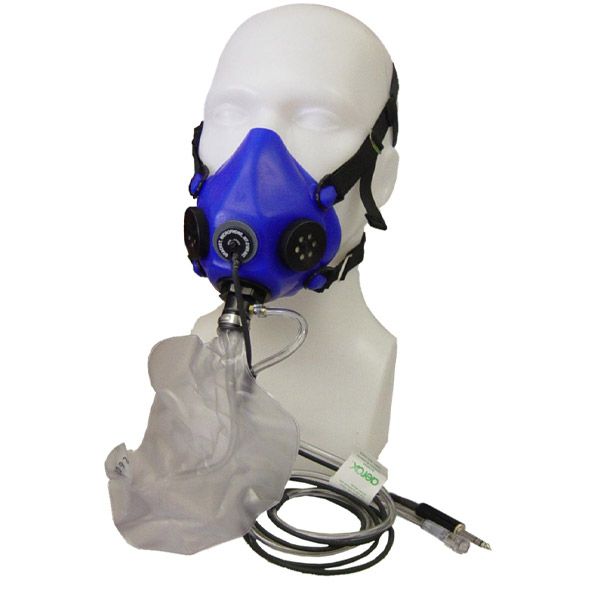Creating an account has many benefits:
- See order and shipping status
- Track order history
- Check out faster
Aerox Microphone Mask Assembly
General Description
Aerox Microphone Mask Assembly - TSO C103 approved mask is a crew mask assembly including the standard re-breather mask and electret microphone. These masks are approved for use up to 25,000'.
Features
- Electret Microphone Mask with High Concentration Partial Rebreather
- For use at or below 25,000′
- Use with Aerox Flowmeter
- Headband with Adjustable Elastic Straps
- Soft Silicone Face Mask with Seal
- 5′ mic cord, 3′ Oxygen hose
- Electret Mic with windscreen per MIL–M–26542D
- PJ068 microphone jack
Aerox Microphone Mask Assembly size varies depending on selection above.
| Manufacturer Part Number | 4110–712–1 Small 4110–712–2 Medium 4110–712–3 Large |
| Available Sizes | Small Medium Large |
| Length | Hose 36″ Microphone Cord 5′ |
| Weight | 0.75 lbs. |
| Material | Mask Face/Silicone Rebreather/Taffeta |
| Inlet | ¼″ O2 Bushing |
| Microphone | Electret With Wind Screen Per MIL–M–26542D |
| Microphone Jack | PJ068 |
| Operating Temp. Range | +20° F To 120° F (–7° C To 49° C) |
| Storage Temperature Range | –20° F To +160° F (–29° C To +71° C) |
| Approvals | TSO–C103, Technical Standard Order for Continuous Flow Oxygen Mask Assembly |
What is Oxygen?
Composition of Oxygen. Oxygen includes 21% of the atmosphere at all altitudes. The remaining atmosphere consists of 78% nitrogen and 1% traces of other gases. Oxygen under normal conditions is an odorless, colorless, tasteless, non–combustible gas. It is the most important single element on earth. At each breath, we fill our lungs with air. Millions of tiny air sacs (known as “alveoli”) in our lungs inflate like tiny balloons. In the minutely thin walls enclosing each sac are microscopic capillaries through which blood is constantly transported, from the lungs to every cell in the body. The blood carries the oxygen extracted from the air in the lungs to every part of the body. Because the body has no way to store oxygen, it leads a breath–to–breath existence. The human body must have oxygen to convert fuel (the carbohydrates, fats, and proteins in our diet) into heat, energy, and life. The conversion of body fuels into life is similar to the process of combustion; fuel and oxygen is consumed, while heat and energy is generated. This process is known as ”metabolism“. The rate of metabolism, which determines the need for and consumption of oxygen, depends on the degree of physical activity or mental stress of the individual. Not all people require the same amount of oxygen. A man walking at a brisk pace will consume about four times as much oxygen as he will while sitting quietly. Under severe exertion or stress, he could possibly be consuming eight times as much oxygen as resting.
How Important is Oxygen in flying?
Let’s understand the importance of bringing more oxygen to the body. Blood is the liquid carrier of oxygen. Blood carries oxygen to all parts of the body to fuel its systems, stimulate its chemical reactions, and rid it of wastes and toxins. The feeling of being tired is the classic sign of oxygen–deficiency or “Hypoxia”. When we are oxygen–deficient, (which occurs at higher altitudes while flying) we are not equipped to have incomplete chemical reactions occur in our body. We don’t burn waste properly and our blood and cells become toxic. Some cells that are deficient in oxygen may mutate into colonies of disease in their battle for survival. Viruses, fungi and bacteria begin to grow. Our whole physical energy level is low and we just don’t feel right; or worse, we catch a debilitating disease. When oxygen levels are increased, our red blood cells pick up the extra oxygen and become energized. We feel better, arrive at our destination less tired and more alert for the all–important part of the flight, LANDING. Our body is healthier and we think more clearly because of increased oxygenation.
FAA and Oxygen
Oxygen Requirements at Altitude. The FAA requires that all pilots flying their aircraft above 12,500′ for 30 minutes or longer or at 14,000′ or above during the entire flight must use supplemental oxygen. The amount required is 1 liter of oxygen per minute for every 10,000′. For example, at 18,000′ there should be a flow of 1.8 liters per minute of oxygen available via a standard breathing device. The FAA requires there should be a device so attached to each breathing device that visually shows the flow of oxygen. (Aerox flow meters meet this FAA requirement.) The FAA also regulates that passengers must have supplemental oxygen available over 15,000′ and that it is recommended that supplemental oxygen be used at night at altitudes over 5,000′.
Why do Knowledgeable Pilots Use Oxygen Over 5000′
You can go without food for days, and water for hours, but if you are denied oxygen for only a few minutes you can’t survive. Oxygen is crucial to your system. Vision is impaired as low as 5000′ especially at night (the FAA recommends oxygen at 5000′ at night). All the physical processes of your body, such as circulation, assimilation, digestion, and elimination “run” on oxygen. As a result, oxygen helps your body produce energy, balance its metabolism, purify itself of wastes, and fights fatigue. Flying tired is not fun.
About Aerox®
Aerox® is a leading designer and manufacturer of aviation oxygen systems and accessories. Since 1981 they have been providing the aviation industry with innovative solutions for all of its oxygen needs.
























